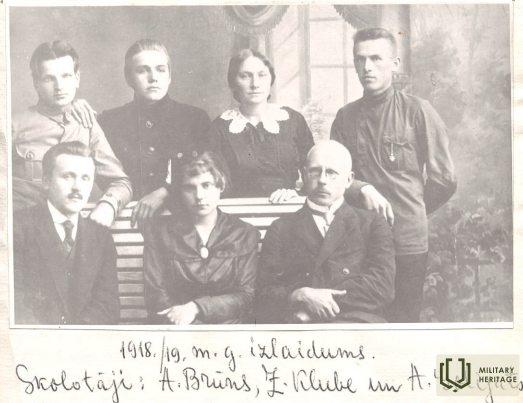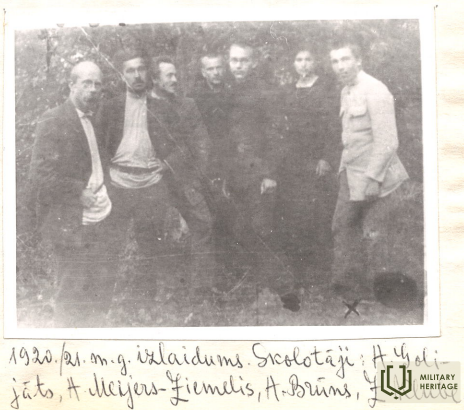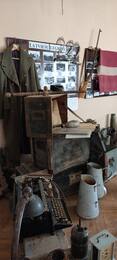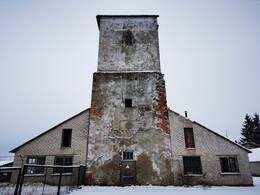Kuidas Läti valitsuse mehed Pampali bolševike kaasjooksjaid narrisid
Pampāli kooli endine direktor (kuni 1959. aastani) Alfred Brūns on käsitsi trükkinud muljetavaldava Pampāli kooli ajaloost ja seda ümbritsevatest ajaloosündmustest koosneva autentsete fotodega raamatu, milles kirjeldab A. Brūns 1959. aasta sõja sündmusi. Iseseisvus Pampālis, kirjeldades üksikasjalikult sündmusi, mis hõlmasid nii Läti riigitegelasi, bolševike toetajaid, Saksa armee tegevusi jne.
[…] 1919
1919. aastal, 6. jaanuari paiku, põgenesid Läti valitsuse ja rahvanõukogu liikmed erinevaid teid pidi Liepāja suunas, vältides Venta suunas voolavaid bolševike ojasid.
Meie endine õpilane (1914 [koolilõpetaja]) Žanis Kummermanis oli Pampāli mõisas organiseerinud bolševike rühma ja see valitses Pampālit juba mitu päeva enne Nõukogude vägede ilmumist Pampālisse.
Pampāļnieks Fricis Vecpuisis - Stunguri majade omanik - Ulmani valitsuse sõjaehituse osakonna juhataja - ohvitser koos mõne teise Läti riigiteenistujaga oli Liepājasse taandudes sisenenud "Stungurisse" hea, valitsuse rekvireeritud limusiiniga. ööbima. Rühm Pampali partisane, keda sellest teavitati, tuli kohe "Stungurosse", et limusiiniga Pampalisse viia. Vanamees ei hakanud vastu – nii kaua kui ta võttis, sest kaugemale ta nagunii ei saanud, oli bensiin viimase tilgani otsas. Lihtsad mõisateenrid uskusid ja läksid sellise sõnumiga Pampaliisse. Saanud teada, milline ametlik Vecpuisis seal on, lahkuti varahommikul 4-6 parima hobusega autot üle andma. "Stungurost" ei leitud ei limusiini, Vecpuisi ega muid valitsusmehi.
Arhiivis on uudis, et Fricis Vecpuisis, sündinud 1890, Stunguri maja, küüditati 14. juunil 1941. aastal.
Tase/tase: juhtumi number/number: 20035
===================
Pampāli kooli endine direktor (kuni 1959. aastani) Alfred Brūns on käsitsi trükkinud muljetavaldava raamatu Pampāli kooli ajaloost ja seda ümbritsevatest ajaloosündmustest koos autentsete fotodega. Raamat asub Pampālis koos Artūrs Hartmaniga, kellele kuulub muljetavaldav erakogu erinevatest antiikesemetest ja Pampāli ümbrusest leitud Teise maailmasõja aegsetest esemetest.
Läti riigiarhiiv (rtu.lv)
www.itl.rtu.lv/LVA/index3.php?id=9009&kods=14072&vien=5
Seotud ajajoon
Seotud objektid
Pampali kirik ja hävinud maja seinad
Pampāļi on asula Salduse maakonnas Pampāļu vallas, valla keskus on Zaņase ja selle lisajõe Arupe kaldal, 27 km kaugusel maakonnakeskusest Saldust ja 147 km kaugusel Riiast. Asula tekkis pärast agraarreformi Pampāli mõisa keskuse ümber. 1933. aastal omistati Pampālisele tiheasustuskoha staatus.
Vaenutegevus Pampali eeslinnas algas 21. novembril 1944, kui Ventat sundinud Nõukogude 4. šokiarmee alustas pealetungi Salduse suunas. 24. novembriks olukord stabiliseerus ja rindejoon püsis muutumatuna kuni 21. detsembrini.
21. detsembril 1944 algas nn 3. Kurzeme lahing, mille käigus ründas 1. Balti rinde 4. põrutusarmee 4 laskurkorpusega (12 laskurdiviisi) ja 3. kaardiväe mehhaniseeritud korpus Salduse suunas, et ühendada. seal 2. Balti rinde üksustega. Pampali rajoonis kaitses end Saksa 132. jalaväedivisjon, mille 436. grenaderirügemendi 1. pataljon oli end mõisa ja kiriku ümbruses kindlustanud.
Rünnak Pampāliaile toimus massiivse suurtükitule toetusel 1. laskurkorpuse 357. ja 145. laskurdiviisi poolt, mida toetas 39. kaardiväe tankibrigaad. Lahingu esimese 24 tunni jooksul piirati Pampali garnison, mida juhtis 436. grenaderirügemendi 14. (tankitõrje) kompanii ülem kapten Eberard Coll, ja hävitati ägedas võitluses.
Kuna Pampali asus otse rindejoonel, said kõik hooned suurtükitulest pihta ja pole tänaseks praktiliselt säilinud.










